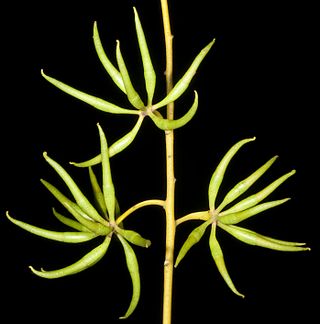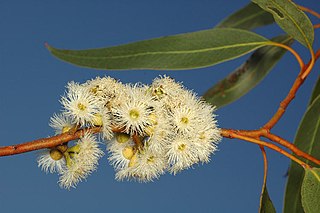
Eucalyptus polybractea, commonly known as the blue-leaved mallee or simply blue mallee, is a species of mallee that is endemic to south-eastern Australia. It has rough, fibrous or flaky bark on the lower part of the trunk, smooth greyish or brownish bark above, lance-shaped adult leaves, flower buds in groups of between seven and eleven, white flowers and cup-shaped or barrel-shaped fruit.

Eucalyptus youngiana, commonly known as large-fruited mallee, Ooldea mallee and yarldarlba, is a species of mallee, less commonly a tree, that in native to arid and semi-arid areas of southern Western Australia and South Australia. It has rough, fibrous bark on some or all of the trunk, smooth bark above, lance-shaped adult leaves, flower buds in groups of three, red, pink or bright yellow flowers and short, broad, conical fruit.

Eucalyptus viridis, commonly known as the green mallee, is a species of mallee or small tree that is endemic to south-eastern, continental Australia. It has rough fibrous or flaky bark on the lower trunk, smooth bark above, linear to narrow lance-shaped adult leaves, flower buds in groups of seven or nine, white flowers and cup-shaped fruit.

Eucalyptus nitida, commonly known as the Smithton peppermint, is a species of tree or mallee that is endemic to Tasmania. It has varying amounts of loose, fibrous or flaky bark, lance-shaped to curved adult leaves, flower buds in groups of nine to fifteen, white flowers and cup-shaped to hemispherical fruit.

Eucalyptus porosa, commonly known as mallee box, Quorn mallee or water mallee, is a species of mallee or a tree that is endemic to southern Australia. It has rough, fibrous or flaky bark on the trunk and larger branches, smooth greyish bark above, lance-shaped adult leaves, flower buds in groups of seven, white flowers and barrel-shaped or shortened spherical fruit.

Eucalyptus serraensis, commonly known as the Grampians stringybark, is a species of small tree or mallee that is endemic to the Grampians in Victoria, Australia. It has rough, stringy, fibrous or flaky bark on the trunk and sometimes also the branches, smooth bark above, lance-shaped to egg-shaped or round adult leaves, sessile flower buds in groups of three or seven, white flowers and hemispherical or cup-shaped fruit.

Eucalyptus morrisii, commonly known as grey mallee, is a species of mallee or straggly tree that is endemic to western New South Wales. It has rough, fibrous or flaky bark on some or all of the trunk, smooth greyish bark above, lance-shaped adult leaves, flower buds usually in groups of three, white flowers and conical or hemispherical fruit.

Eucalyptus flavida, commonly known as yellow-flowered mallee, is a species of mallee that is endemic to Western Australia. It has smooth greyish bark, sometimes with rough, flaking brownish bark at the base, lance-shaped adult leaves, long, elongated, tapering flower buds in groups of nine or eleven, yellow flowers and cylindrical or barrel-shaped fruit.
Eucalyptus laevis is a species of mallee or tree that is endemic to Western Australia. It has thin, rough, fibrous or flaky bark on the trunk, smooth bark above. Its adult leaves are linear to narrow lance-shaped, the flower buds are arranged in groups of between seven and eleven, the flowers are white and the fruit is cylindrical to barrel-shaped.

Eucalyptus mannensis, commonly known as Mann Range mallee, is a species of mallee that is native to Western Australia, South Australian and the Northern Territory. It has rough bark at the base of the trunk, smooth bark above, narrow lance-shaped adult leaves, flower buds in groups of between seven and eleven, creamy white flowers and hemispherical fruit.

Eucalyptus petraea, commonly known as granite rock box, is a species of mallee or a small tree that is endemic to Western Australia. It has thin, ribbony or flaky to fibrous bark on the lower trunk, smooth greyish above, lance-shaped adult leaves, flower buds usually in groups of seven, creamy white flowers and conical fruit.

Eucalyptus platycorys, commonly known as Boorabbin mallee, is a species of mallee, rarely a small tree, that is endemic to Western Australia. It has rough, dark grey, fibrous and flaky bark on the trunk, smooth greyish bark above, lance-shaped adult leaves, flower buds usually in group of three, creamy white flowers and cup-shaped to cylindrical fruit.
Eucalyptus semota, commonly known as marymia mallee, is a species of mallee or small tree that is endemic to a small area in central Western Australia. It has rough, flaky to fibrous bark on the trunk, smooth grey or brown bark above, linear to narrow lance-shaped leaves, flower buds in groups of seven or nine, white flowers and conical to cup-shaped fruit.

Eucalyptus corrugata, also known as rough fruited mallee or rib-fruited mallee, is a species of tree or mallee that is endemic to Western Australia. It has rough scaly or fibrous bark on the lower part of its trunk, smooth bark above, glossy, lance-shaped adult leaves, prominently corrugated flower buds arranged in groups of three in leaf axils and ribbed, conical to cup-shaped fruit.

Eucalyptus cylindrocarpa, commonly known as the woodline mallee, is a species of mallee that is endemic to Western Australia. It has mostly smooth bark, sometimes with loose fibrous or flaky bark near the base of the trunk, linear to lance-shaped or curved adult leaves, flower buds in groups of seven, nine or eleven and cylindrical to barrel-shaped fruit.
Eucalyptus filiformis is a species of mallee that is endemic to a small area on the side of a mountain in Victoria, Australia. It has rough fibrous or flaky bark on the trunk, smooth bark above, narrow lance-shaped to narrow elliptical adult leaves, flower buds usually in groups of seven, white flowers and barrel-shaped fruit.
Eucalyptus pleurocorys is a species of mallee, sometimes a tree, that is endemic to Western Australia. It has rough, flaky or fibrous bark on the lower part of the trunk, smooth bark above, lance-shaped or curved adult leaves, flower buds in groups of between seven and eleven and conical fruit.
Eucalyptus capitanea, commonly known as the desert ridge-fruited mallee, is a species of mallee that is endemic to South Australia. It often has rough, flaky bark on the lower part of the trunk, smooth bark above, lance-shaped adult leaves, ribbed, oval flower buds in groups of seven, cream-coloured flowers and ribbed, urn-shaped fruit.
Eucalyptus longissima is a species of mallee or small tree that is endemic to the south-west of Western Australia. It has rough, fibrous or stringy bark on the trunk, smooth greyish brown bark above, glossy green, lance-shaped adult leaves, flower buds in group of between seven and thirteen, white flowers and shortened spherical fruit.
Eucalyptus yarriambiack is a species of small, spreading tree that is only known from a single population in Victoria, Australia. It has rough, fibrous to flaky bark on the trunk, smooth bark above, narrow lance-shaped to elliptical adult leaves, flower buds in groups of seven to eleven, white flowers and hemispherical to cup-shaped fruit.












